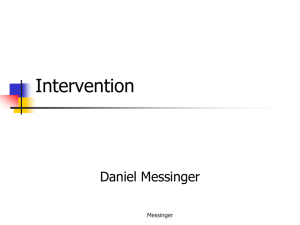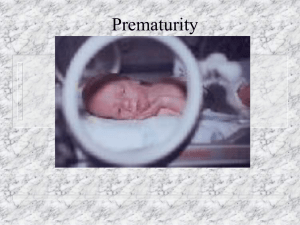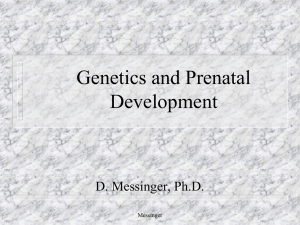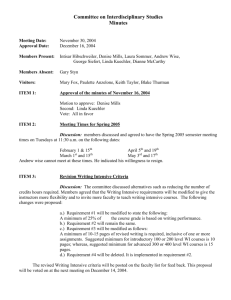Development: Definition and methods
advertisement
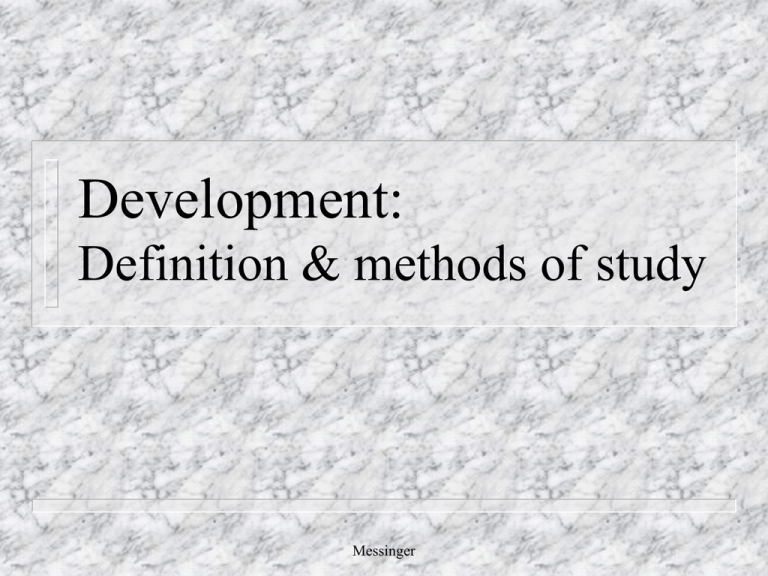
Development: Definition & methods of study Messinger Overview Defining development Studying development – Study design – Longitudinal & cross-sectional designs Experimental, observational, and qualitative studies Predicted variables – typically behavior and/or physiologic activity Messinger Development defined Individual change that is, normative, nonreversible, relatively stable, and sequential. Messinger Development defined defined Normative process – non-reversible – reorganization of the entire person relatively stable – everyone’s doing it you can’t go back, sequential change – crawl before you walk Examples Messinger Is development Increasing functionality in all things? – – Loss of perceptual acuity in non-native languages Old-age Headed toward a goal? – – – Development has normative outcomes, but time goes forward prior events cause subsequent events not the opposite Messinger Canalization (Waddington) Messinger Overview Studying development – Studying behavior – Experimental and observational Studying outcomes – Longitudinal and cross-sectional Behavior and physiology Relate to your article reviews and final projects Messinger Longitudinal Same infants over time Pro: Answers ‘How do individuals change in time?’ Con: Takes a long time – Attrition Final project examples? 120 110 Bayley Cognitive Score Typical Trajectory: Cognitive Scores Decline 100 90 80 70 60 50 1 Year M = 93.5 n = 200 Messinger 2 Years M = 79.1 n = 190 3 Years M = 82.1 n = 132 Cross-sectional Different infants at different times Pro: Efficient, large numbers of subjects Con: Differences do not necessarily reflect individual’s development – e.g. cohort Final project examples? Messinger 95 90 85 80 75 70 65 60 55 50 One Year Two Year Three Year Different Individuals Longitudinal vs. cross-sectional Development is relatively stable on large time scales – But choppy on smaller scales – Motor, physical, emotional, communicative Only longitudinal research can show this Emergent order from chaotic, dynamic systems Previous example? Messinger Hypothetical applied example from Lamb et al. Messinger Individual differences Messinger Complementary, not exclusive A single study can combine longitudinal and cross-sectional methods Some infant studies use neither method – They look at behavior at one point in time E.g., Neonate study Messinger Predictor and predicted variables In developmental studies, – – age is a predictor behavior or physiology are predicted Experimental and observational studies Messinger Stability and continuity Stability – Rank of individual in group is stable Continuity – Level of behavior is continuous across ages Messinger Experiments are unique because They can demonstrate causality How? Estimated Marginal Means Estimated Marginal Means of MEASURE_1 .16 .14 .12 .10 .08 .06 EXP2 .04 Comparison .02 Exposed 1 SMILES Messinger 2 3 Experimental design Between subject – – A treatment (independent variable) is assigned randomly creating treatment and control groups Within-subject – – All infants get treatment and control Examples Rating Estimated Marginal Means study, Face-to-face still-face Estimated Marginal Means of MEASURE_1 .16 .14 .12 .10 .08 .06 EXP2 .04 Comparison .02 Exposed 1 SMILES Messinger 2 3 Constrained behavior in experiments Gazes at stimulus – habituation and paired preference designs Sucking & leg kicks – Response contingencies Messinger Types of observational research Quasi-experimental – differences in naturally occurring groups Observational – Differences in naturally occurring conditions Complementary, not exclusive Is age (development) studied experimentally or observationally? Messinger Observational Quasi-experiment – Between subject exploration of differences in naturally occurring groups Drug Observational – Differences in naturally occurring conditions Gazing at mother versus gazing away Messinger 0.8 Proportion of Open Mouth Smiling Only exposure, breast-feeding, and attachment groups Figure 2b. Solo Open Mouth Smiling by Gazing at Mother 0.7 0.6 0.5 0.4 0.3 0.2 0.1 0.0 Predicted or dependent variables Experimental and all observational approaches measures variables Variable - a measurable component of behavior or physiological functioning that can take on different values Not all aspects of behavior or physiology by specific feature of interest Messinger Qualitative methods Intensive description in regular language – Not measuring variables Pro: Insight into individual and developmental process – E.g., baby biography, one infant described over time Emerged with romantic emphasis on individual Con: Not generalizable Complementary, not exclusive – Role in empirical project Messinger Which is best? Longitudinal or cross-sectional Experimental, observational, or qualitative? Messinger Observing behavior Observed on-line or video-recorded Measured with – – – – Trait rating - global judgement Time sampling Event sampling (frequency) Event sampling (duration) Messinger Time-sampling & event-sampling Messinger Messinger Physiological measures Heart rate & respiration (video) – Electroencephalogram – Relative lateral activation during crying Actigraphy – avoidant infants, infants on visual cliff Index of ADD? Increasingly important supplement to behavioral measures Messinger Adequacy of measures Reliability – Consistency of measurement Inter-rater reliability of observations Bias – Systematic impact of unmeasured variables Blinding in drug studies Keeping observations independent Messinger Validity Are we measuring what we think we’re measuring, – – Do the variables measured the constructs mentioned in the research questions? There is no final answer Reunion behavior = Attachment? Smiling = Joy? Looking = Preference? Heart rate = Arousal? Messinger References Infancy (Fogel) Development in infancy (Lamb, Bornstein, & Teti) Messinger

